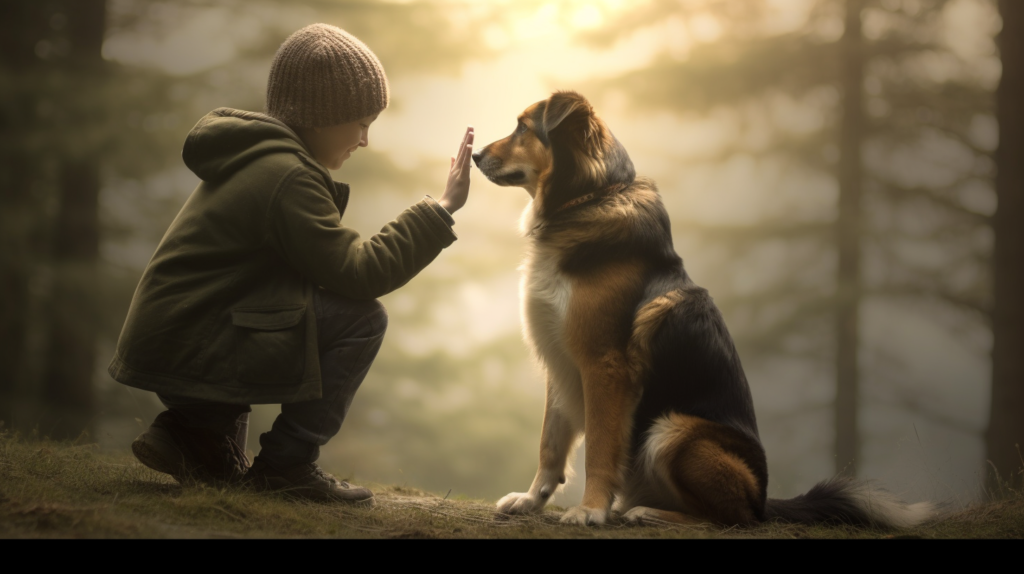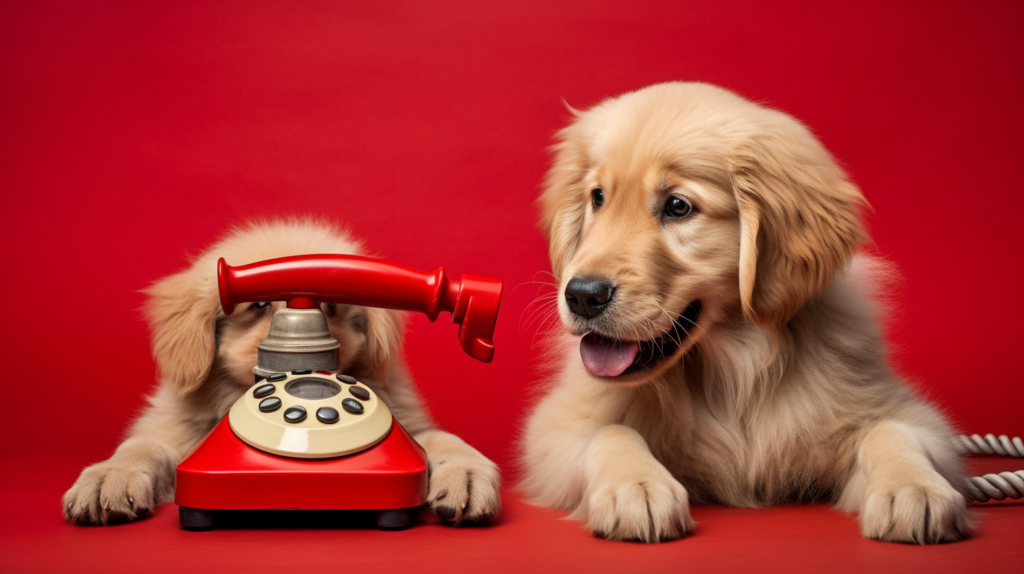When you think of communicating, we usually think in terms of words being exchanged between two people. But have you ever considered that there may be even more power to be harnessed from communication by incorporating our four-legged friends? Unlocking the potential of pet communication can be a powerful, lifechanging experience, and allows us to explore avenues of communication we never thought possible.
1. The Incredible Language of Pets
The special language of pet communication can be incredibly fascinating. Our furry friends use a variety of sounds, noises, body signals, and other expressions of emotion to communicate.
When your pet meows, purrs, or gives you a tail wag, there is a unique meaning behind it. Here are some of the common interpretations:
- Meowing – your feline friend may meow if they feel neglected or want your attention.
- Purring – this sound usually indicates happiness. Sometimes cats may purr when they are in pain too.
- Whining – this quiet noise may be a sign that your pet needs something, like food, the litter box, or attention.
So the next time you have an encounter with one of your pet friends, take a moment to consider what they might be trying to communicate with you! It’s likely their unique language contains clues and hints into their wants and needs.

2. The Power of Pet Communication
Humans have been communicating with animals for centuries, but only recently have we begun to use the power of our combined intelligence and empathy. Through the use of verbal and non-verbal cues, pet communication can provide owners with an invaluable insight into their pet’s behavior and needs.
Pet communication is key to providing the kind of care that animals need to stay happy and healthy. Understanding body language, vocalizations, and behavioral changes can help owners to assess their pet’s mood and wellbeing. Knowing when a pet is excited or anxious can help owners to modify their behavior accordingly, providing the right environment for their pet to learn, play, and rest.
Not only does pet communication enable owners to better understand their pet and foster a stronger bond, it can also help to diagnose and address any behavior or health issues they may be having. By becoming more adept at recognizing and interpreting pet communication, owners can act quickly and effectively when their pet needs help. Unnumbered lists are often useful in understanding pet communication:
- Involving multiple senses – visual, tactile, auditory, and olfactory cues
- Observing body language – tail position, ears, facial expression, breathing rate, posture
- Paying attention to vocalizations – volume, pitch, tone
- Inquiring about the pet’s needs – hunger, thirst, exercise, comfort, companionship
Thanks to improved understanding of animal behavior, pet communication has become a powerful tool to enhance the bond between pet owners and their furry friends.
3. Enhance Your Bond Through Communication
Clear, consistent communication is one of the most important elements of any relationship. Getting to know each other is a process of continual communication, and by keeping the lines of communication open, you can develop a strong emotional bond with your significant other.
Discuss Everyday Things. Create a habit of discussing the small details of everyday life. This is one of the most natural ways of strengthening your connection. Talk to each other about anything and everything, and take the time to really listen and understand each other’s perspectives. Doing this regularly will boost communication, and help you two understand each other better.
Try Something New. Embrace a creative and positive atmosphere to encourage more heartfelt conversations. Instead of talking about work or finances, plan something out of the ordinary. Take turns in coming up with new activities to keep the conversations dynamic and interesting. This can range from engaging in a group video game, to going on a short road trip. Being adventurous together can help you two bond even more.
Be Open and Honest. Make sure that happy conversations don’t turn into arguments. To stay connected, be honest without blaming each other. Share your feelings without projecting your frustrations on one another. Remember, you two are a team, and have each other’s backs. Being honest is one of the best ways to enhance your bond and ensure a smooth relationship.

4. Unlock Your Pet’s Potential
It’s no secret that our four-legged friends have minds of their own. While it’s impossible to tell what’s going through their furry heads, it is possible to help your pets reach their full potential. Here are 4 ways to get your furry friend feeling their best:
- Provide proper nutrition. Feeding your pet a healthy, balanced diet that meets their nutritional needs is essential for their wellbeing. After all, they need to fuel up for all the fun that’s ahead!
- Introduce activities. Dogs and cats both enjoy physical activity and playtime, whether it’s fetching a ball or chasing after a feather wand, find activities your pet likes and bond with them while they enjoy it.
- Socialize. Pets whose owners provide them with lots of social interaction are more confident and less likely to develop anxiety. So spend some time getting to know your pet, taking them for walks and participarting in activities together.
- Encourage creativity. Did you know that many cats are actually skilled painters? Believe it or not, it’s true. Encouraging your pet to engage in creative activities can help reduce boredom and lastly, unleash their true potential.
By taking the time to nurture your pet’s unique skills and abilities, you can help create a strong and positive bond between you and your furry friend. So why not unleash their inner brilliance and unlock their full potential today!
5. Unleashing the Art of Pet Communication
Animals and humans share a special bond that goes beyond loyalty and the provision of affection. For decades, researchers have studied inter-species communication, and the art of understanding animals’ silent language is one that has been mastered by few. It is often said that animals cannot express themselves verbally, but learning how to interpret their body language, vocalizations, and behavior can help you understand their emotions and needs.
By taking the time to interpret the messages animals display through their body, you can build a better connection with them. A few tips to keep in mind when attempting the art of pet communication:
- Trust your instincts and take your time; be patient.
- Observe postural expressions and body language to determine how an animal is feeling
- Pay attention to vocalizations and the type of noises they make
- Notice the behaviors the animal displays
- Take cues from their environment and note any changes
Once you understand the way animals communicate, you can help them feel more secure, motivated, and obedient. This understanding also allows you to adequately anticipate their needs and actions. can profoundly improve the quality of your relationship with your beloved fluffy friend!

6. A Guide to Interpreting Pet Signals
Every pet is its own individual, and each brings its own set of signals and cues that indicate what it needs and how it’s feeling. Interpreting these can be challenging, even for the most experienced pet parent, but understanding the signals your pet sends out can help you to build a stronger and more meaningful bond with them.
Body Language and Physical Clues
Body language is often the most obvious way to interpret your pet’s state of mind – if they’re relaxed and happy, their body will have a noticeably different shape. Happy pets generally have a loose, relaxed posture, and will show few or no signs of agitation. Likewise, if they are anxious or nervous, their body language will be much more tense – ears flat against their head, fur standing on end, and a withdrawn tail can all indicate fearful or emotionally manipulated states.
Vocal Cues and Sounds
Most cats and dogs are more vocal than their owners realize – good intepretation of these subtle vocal cues can be helpful for bonding with and understanding your pet. Generally, positive vocalizations – like yips, meows and purrs – denote happy, comforted pets. The sound of growling and snarling, meanwhile, is a sign of something being wrong. Pay attention to the varying levels and tones of your pet’s vocalizations, as these can offer a lot of information that body language cannot.
Other Physical Signs
Aside from body language and vocalizations, there are plenty of other physical signs you can watch out for, such as:
- Ears: pulled back and folded can indicate fear or anxiousness
- Panting: can signify happiness, excitement or fear
- Licking: can show submission, happiness or stress
- Tail: erect and wagging shows happiness; tucked away can indicate fear
These subtle signs will help you better understand your pet’s emotions, needs and wants, allowing both of you to build a stronger connection. Remember, every pet is unique – be sure to take the time to get to know your pet and pick up on the little nuances that indicate how your pet feels.
7. Unleash the Power of Pet Communication
From barking to purring, it’s time to ! While it can be difficult to figure out the meaning behind their various cues, understanding your pet’s language can be a powerful tool in building your connection with them.
Different pets communicate differently. Dogs use facial expressions and body language, with their tails being one of the most communicative features. Cats utilize sounds, smells, and even their fur to share information with their owners.
- Barks/barks vary: Barks often mean different things depending on their volume, duration, and pitch. A loud series of deep and short barks is typically a sign of excitement while small, high-pitched barks could indicate their feeling scared or anxious.
- Meows: Meows are more multi-purpose pet communication. A long drawn out meow might mean they are feeling lonely while a short meow could suggest they are curious.
- Physical behavior: It’s also important to pay attention to physical behavior when interpreting your pet’s communication. Ears back and tail tucked between the legs usually mean they’re scared, while pricked ears and a wagging tail is a sign of contentment or excitement.
By paying close attention to your pet’s body language and vocal cues, you’ll have a better understanding of their needs and desires. In understanding your pet’s language, you can build a stronger relationship and give them the best care you can.

8. The Gateway to Enhance Pet-Human Relationships
Strengthening the bond between humans and their pets is always essential. After all, they are family and much more than just animals. As modern technology changes and advances, so do the opportunities for enhancing pet-human relationships.
The use of gadgetry has enabled us to communicate in many forms with our beloved companions and to make sure they are well taken care of. For instance, you can track their whereabouts with GPS collars. You can also monitor their health with technologically advanced wearables. Apple recently introduced their Apple Watch for senior dogs, which monitors signs of anxiety and fatigue and alerts you of a potential medical issue.
The gateway to refine your relationship with your pet is here. Through the innovative support of technology, it is now easier than ever to keep your furry friends safe, secure, and content. You can set up cameras to watch them while you’re away, talk to them from anywhere throgh video chat apps, and even buy them interactive toys powered by AI. The possibilities are truly endless.
- GPS collars and other wearables
- Apple Watch for senior dogs
- Cameras to monitor your pets
- Video chat apps
- Interactive toys powered by AI
Pet communication is a powerful tool that has become more accessible thanks to modern technology. As advances in communication and understanding continue to develop, so do pet owners’ opportunities for understanding their furry friends. Unlocking the secrets of pet communication can benefit both owners and their pets alike—so why wait to unleash the power?
